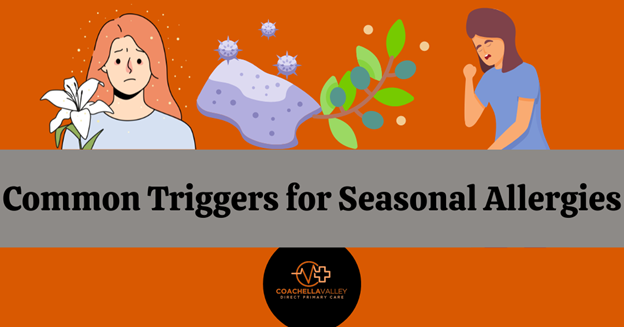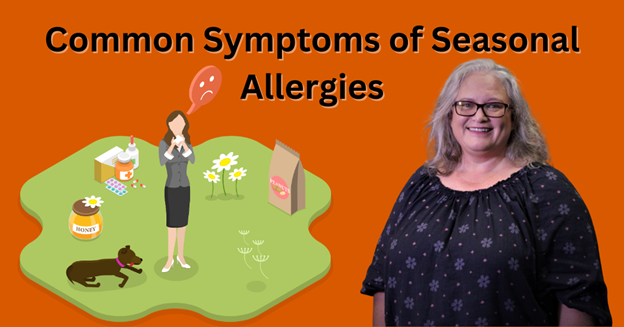Have you ever stepped outside, taken a deep breath, and instantly regretted it? Your eyes water, your nose runs like a faucet, and suddenly you’re sneezing more than an audience at a pepper festival. Welcome to the often underestimated world of seasonal allergies. It’s not just about sniffles or the occasional “achoo!” For many residents in the Coachella Valley, this is a calendar-marked period of discomfort that could rival any summer blockbuster for its intensity and unwelcome drama.
The culprits? A motley crew including dust mites doing backstrokes in your living room carpet or pollen from those picturesque trees lining our streets – nature’s confetti indeed. But here’s where it gets interesting; these seemingly innocuous particles are leading double lives as villains in disguise for our immune systems. And while some might dismiss seasonal allergies as merely inconvenient, anyone who’s found themselves locked in mortal combat with their own sinuses knows there’s more to this story.
Coachella Valley Direct Primary Care
Frustration-free health care for the whole family. A monthly membership program designed for the busy Coachella Valley family to give you direct access to primary healthcare services so you can be healthy and active. Schedule a free consultation. 760-642-5549
Table Of Contents:
- Understanding Seasonal Allergies and Their Impact
- The Timeline of Allergy Seasons
- Identifying Your Allergy Triggers
- Common Symptoms of Seasonal Allergies
- Treatment Options for Seasonal Allergies
- Conclusion
Understanding Seasonal Allergies and Their Impact
What Are Seasonal Allergies?
Think of seasonal allergies as nature’s unwanted gift. They’re your immune system‘s over-the-top reaction to stuff that usually doesn’t bother other folks. Your body sees them as invaders and goes all out in defense mode. This means sneezes, sniffles, and those oh-so-itchy eyes.
The science bit? When these foreign substances float into our lives, our bodies produce antibodies called Immunoglobulin E (IgE). These guys trigger the release of histamine which is basically what turns you into a sneezy mess every spring or fall.
Common Triggers for Seasonal Allergies

- Pollen: It’s not just one type but a mix from trees, grasses, and weeds. Tree pollens start their tour in spring while grasses take over in summer followed by weeds in fall.
- Dust Mites: These tiny critters are year-round troublemakers but they throw bigger parties during humid seasons.
- Mold Spores: Mold loves damp areas making basements or piles of wet leaves perfect spots for mold spores to kick off allergic reactions.
- Animal Dander: Fluffy may be cute but his dander can cause issues throughout the year especially when homes are sealed up tight during cold weather months.
Allergy triggers vary greatly with each season bringing its own set of challenges to those sensitive souls among us. But knowing what sets off your symptoms can help big time. You might dodge tree pollen only to get knocked down by ragweed or hay fever. Keeping an eye on the allergy forecasts in your area and preparing yourself can make a world of difference.
To sum it up: Yes, dealing with seasonal allergies feels like being stuck in an endless battle against invisible enemies. But hey. Knowledge is power, right? Understanding what ticks off your immune system gives you a fighting chance at enjoying every season—sneezing fits notwithstanding.
Key Takeaway:
Beat seasonal allergies by knowing your triggers, from pollen to pet dander. Stay informed with local forecasts and prep ahead to enjoy every season without the sneeze.
The Timeline of Allergy Seasons
Let’s break it down: when are you most likely to find yourself reaching for a tissue or an allergy pill? Understanding when allergies hit their peak will arm you for the sniffly times on the horizon.
Spring Allergies: Tree Pollens Take Center Stage
Right when we start enjoying those early blooms, spring allergies hit us. Starting in February and lasting until early summer across the United States, tree pollination is the first to make our noses twitch. If winter was mild, expect these guys to show up even earlier, eager to get going.
Summer Sneezes: Grass Pollen Enters The Scene
Come late spring and throughout summer, grass takes over as the main irritant. For folks living in tropical climates, this could be a year-round saga. And if spring brought along plenty of rain? Brace yourselves; rapid plant growth means more pollen – and mold. Yep, that’s right—mold increases with moisture too.
Fall Allergies and Ragweed Season
- Ragweed waits for no one; blooming from August till November.
- In many places, September sees peak ragweed pollen levels — not exactly music to our ears (or noses).
The takeaway here? Know your seasons and their respective villains because forewarned is forearmed, my friends.
Identifying Your Allergy Triggers
Finding out what exactly makes your nose twitch and eyes water is like being a detective in your own life. It’s crucial, yet can feel like a puzzle with too many pieces.
The Role of Skin Testing
Have you ever stumbled upon the concept of skin prick tests? They’re not as scary as they sound. Actually, they’re quite uncomplicated when you get down to it. A tiny amount of various allergens gets introduced to your skin, usually on the forearm or back. Then you wait for the magic – or reaction – to happen.
If there’s an area that swells up and turns red, bingo. You’ve just identified one of your triggers. This test helps narrow down the suspects from “everything under the sun” to specific villains like pollen, pet dander, or dust mites.
Consulting with a Care Provider
But let’s be real; interpreting these tests isn’t something you do over breakfast. That’s where professional help comes in handy.
Talking to a direct primary care provider, especially one specialized in allergies, can give you insights beyond what any DIY approach offers. They’ll take those test results and translate them into actionable steps for managing symptoms—whether through medication, lifestyle adjustments, or both.
Note: Always check with professionals before starting any new treatment plan.
- Skin testing helps pinpoint specific allergens causing trouble.
- Leaning on a healthcare expert’s wisdom is crucial to crafting a successful plan to tackle allergies, informed by diagnostic results.
Allergies might make us sneeze and itch but figuring out their triggers doesn’t have to be guesswork anymore—with the right tools and expert advice we’re all set to breathe easier (and clearer).
Common Symptoms of Seasonal Allergies

When the seasons shift, so does our body’s reaction to the world around us. For many, this means a head-on collision with seasonal allergies. Let’s break down those tell-tale signs that spring or fall isn’t just about blooming flowers and changing leaves.
Nasal Symptoms
A runny nose might seem like no big deal until it’s your nose that won’t stop running. And sneezing? Every day feels like you’re breaking your own personal best in the sneeze marathon. But wait, there’s more – ever felt like you’re breathing through a straw? That stuffy nose is another classic sign your body is fighting off those invisible invaders called allergens.
- Runny Nose: It’s not just water; it’s your immune system in overdrive.
- Sneezing: Nature’s way of saying “Nope” to pollen and dust mites.
- Stuffy Nose: When air becomes an elusive treasure thanks to swollen nasal passages.
Eye Irritations
Your eyes are windows to the soul but also prime targets for allergens. Enter stage left: itchy, watery eyes – nature’s cruel joke making you look like you’ve watched too many sad movies back-to-back. Redness joins the party too because why not add some vampire vibes into the mix?
- Itchy Eyes: The relentless urge to scratch that makes focusing on anything else nearly impossible.
- Watery Eyes: Your peepers trying (and failing) at their best impression of Niagara Falls.
- Red Eyes: Because apparently looking well-rested is overrated during allergy season.
Treatment Options for Seasonal Allergies
But fear not. We’ve got a slew of weapons in our arsenal to combat those sniffles, itchy eyes, and sneezes.
Over-the-Counter Solutions
The first line of defense? Over-the-counter (OTC) medications. For swift alleviation of minor ailments, these readily available remedies spare you a trip to the physician’s office.
- Allergy Medications: Pills or liquids that can ease many symptoms with just one dose a day. They’re like the Swiss Army knife of allergy relief.
- Nasal Sprays: A direct hit to nasal congestion and stuffiness. Think of them as your nose’s best friend during high pollen counts.
- Treatment Plan: Sometimes mixing it up helps—using both pills and sprays based on what part of you is under siege by allergens.
We’re talking about options ranging from antihistamines that block the body’s allergic response to decongestants that clear up all that traffic jam in your nose. And let’s not forget steroid nasal sprays which reduce inflammation directly where it hurts – right in your sinuses.
Bear in mind though; these OTC meds aren’t cure-alls but rather symptom managers. If you’re noticing little improvement or if side effects cramp your style, calling up your direct primary care provider might be wise. It’s all about finding what works best for you because when it comes down to allergies, everyone reacts differently.
To wrap this section up: Don’t let seasonal allergies hold you hostage indoors while life blooms outside. There are plenty of over-the-counter solutions ready at hand giving us back control over our days (and noses). Whether through an antihistamine pill before bed or a squirt of nasal spray pre-morning jog – managing seasonal allergies has never been more accessible.
Key Takeaway:
Don’t let allergies win. With over-the-counter meds like antihistamines, nasal sprays, and decongestants at your disposal, managing symptoms is a breeze. Mix and match to find your perfect relief combo.
Conclusion
So, we’ve journeyed through the sneeze-filled world of seasonal allergies in Coachella Valley, from understanding their root causes to identifying our personal triggers and exploring ways to fight back. It’s clear that while nature might be plotting against us with its arsenal of pollen and dust mites, knowledge is our best defense.
We now know that combating these invisible foes starts with recognizing what sets off our sniffles and itchy eyes. Equipped with this understanding, we’re able to customize our approach to defense, from grabbing antihistamines off the shelf to seeking bespoke advice from a healthcare professional.
The key takeaway? Seasonal allergies might have us feeling like we’re starring in a never-ending thriller where tissues are our only ally, but they don’t have to write the script for our daily lives. With the right approach, we can reclaim control from these microscopic marauders and breathe easy once again.
This isn’t just about surviving another allergy season; it’s about thriving despite it. We’ve equipped ourselves with the tools needed not just to endure but to overcome. So here’s to clearer skies (and sinuses) ahead – because when you understand your enemy as well as you do now, victory is not just possible; it’s inevitable.

